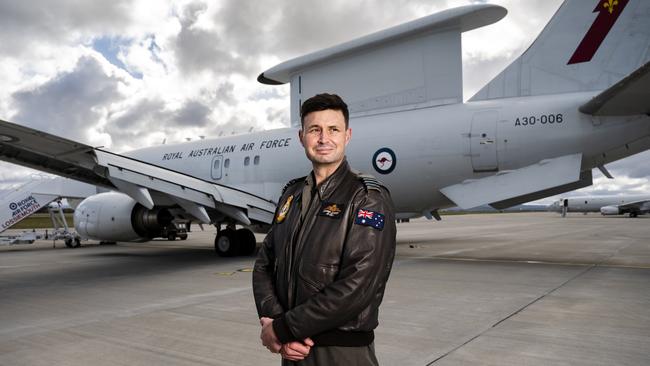Allies embrace our hi-tech Wedgetail
Australia’s Wedgetail E7 early warning surveillance aircraft has begun its trip home to the RAAF base in Williamtown, NSW after six months with US and NATO members.

Australia’s Wedgetail E7 early warning surveillance aircraft has begun its trip home to the RAAF base in Williamtown, NSW after six months with US and NATO members protecting vital supply lines of military and humanitarian aid into Ukraine.
Last year the US asked Australia to fill a six-month capability gap helping to oversee European airspace, using one of the RAAF’s six Wedgetails.
The highly sophisticated plane, which looks like a regular commercial airliner with a large keel-like structure on its roof, boasts advanced technologies and radar, and was able to pick up activity in the region.
Flight radar websites have shown it flying in Poland, close to the Ukrainian border.
Wing Commander Darrin Lindsay, 2 Squadron commander, told The Weekend Australian the plane “operated within European airspace: we never entered Russia, Belarusian or Ukrainian airspace”. He said the plane “was regularly on the night shift and sometimes on patrol waiting and then reacting to what was in the environment’’.
Commander Lindsay said the European experience offered a rare chance to operate in crowded airspace, which meant the team of people and computers had to understand “what was right, what was wrong and what was civilian (aircraft)’’. It also meant the aircraft, more used to operating in hot environments in Australia, or Middle East deployments in Iraq, was covered in snow on occasions.
“The aircraft had half a foot of snow on it, first time I had personally seen it,’’ Commander Lindsay said, noting decisions whether to de-ice were “judgment lessons”.
About 100 RAAF personnel were on the deployment, mainly at the NATO allied air command base in Ramstein, Germany.
Specifics of the operation are classified but the Australian Defence Force says the Wedgetail aircraft can detect maritime and airborne targets using multi-role electronically scanned array radar with a range beyond 400km, electronic warfare self-protection measures and enhanced communication systems. It can be deployed for long-range missions because of the ability to refuel in-flight.
Commander Lindsay said this particular Wedgetail had been enhanced with Starlink, providing connectivity not normally available on other platforms.
Some British military officers are embedded with the Wedgetail in Williamtown as the Royal Air Force is in the process of procuring three of the aircraft. Germany too is buying some Wedgetails.
Australia’s high commissioner to the UK, Stephen Smith, was in Lossiemouth, Scotland, where the Wedgetail had landed for a short stop on Thursday before arriving back in Australia.
Amid the noise of six Typhoon FGR4 planes taking to the skies over the North Sea, and standing on the tarmac between some US naval planes and a fleet of Poseidon MRA1 aircraft, which help to locate and track submarines, Mr Smith explained the Australian Wedgetail operation had been substantial, helping protect the allies’ logistics hub that sees military and humanitarian assistance going into Ukraine.
“As well as making a substantial contribution to Ukraine, it also provided a substantial working engagement with German colleagues from NATO and our UK colleagues,’’ he said.
“Our Wedgetail fleet is based in Williamtown, and the UK is growing its own Wedgetail fleet, officially three (planes) and expectations that that will grow, so the UK RAF embedded staff into Williamtown to get expertise.
“The Germans are also acquiring a Wedgetail fleet so having the operation run out of Germany is important.”
Mr Smith said Australia had been asked by the US to fill a six-month capability gap. “We were very happy to provide that … with complementary benefits in relation to the UK and Germany. We haven’t been asked to extend our six months and I am not aware any other country (was) asked to provide that contribution.’’
Last month Australia agreed to join the Drone Coalition alongside the UK and Latvia, aiming to deliver one million drones, spare parts and training to Ukraine.




To join the conversation, please log in. Don't have an account? Register
Join the conversation, you are commenting as Logout